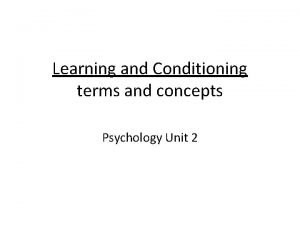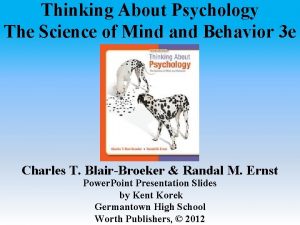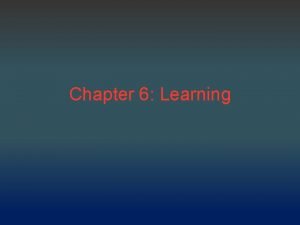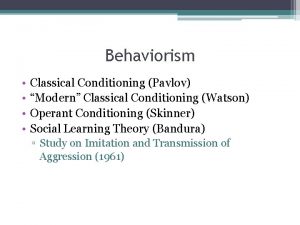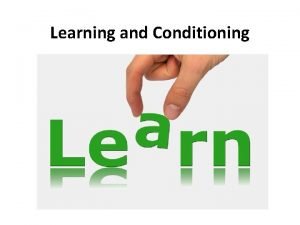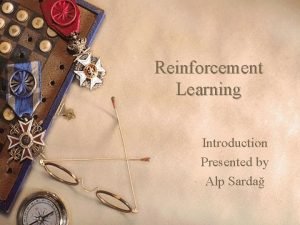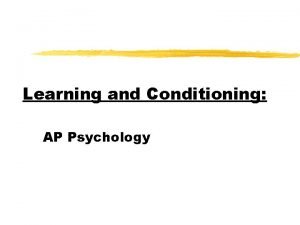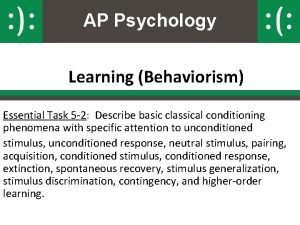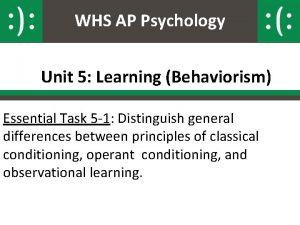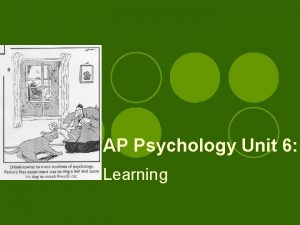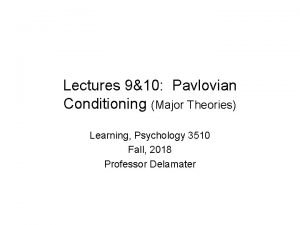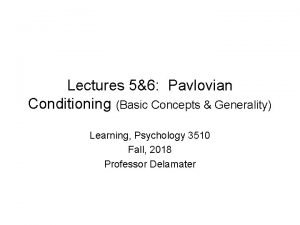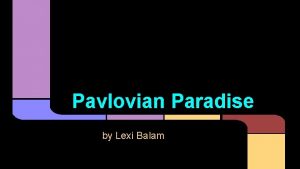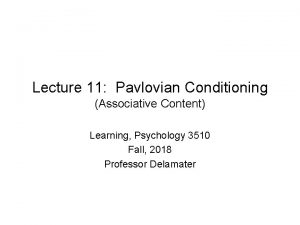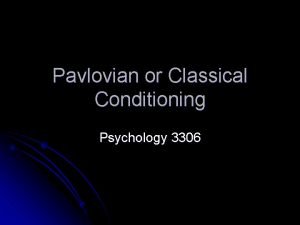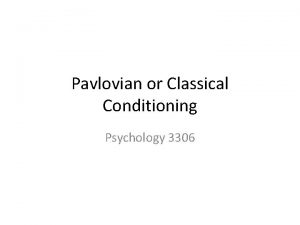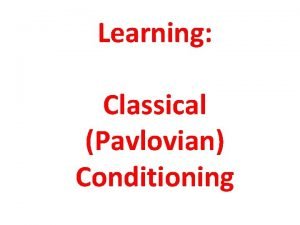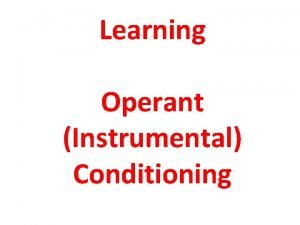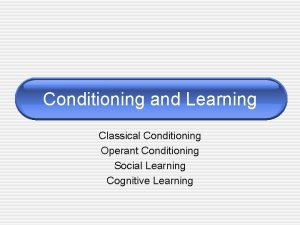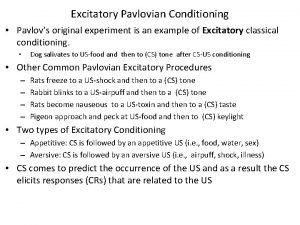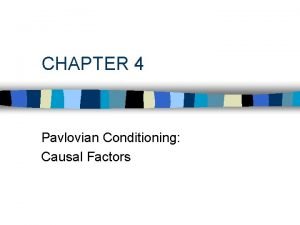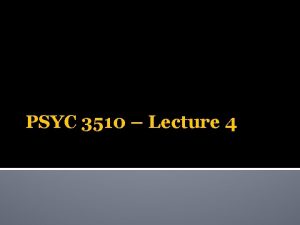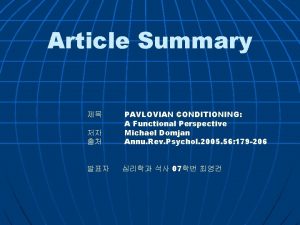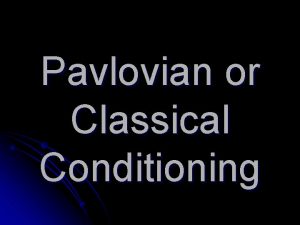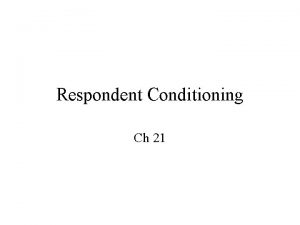Lectures 12 13 Pavlovian Conditioning LearningPerformance Learning Psychology


















- Slides: 18

Lectures 12 & 13: Pavlovian Conditioning (Learning-Performance) Learning, Psychology 5310 Fall, 2018 Professor Delamater

Pavlovian Learning Three Key Questions 1. What are the major determinants of learning? 2. What is the content of learning? 3. How does learning get translated into performance?

Pavlovian Learning: Factors Affecting the Conditioned Response 1. 2. 3. 4. Nature of the US Nature of the CS CS-US Interval Decision Processes: Timing & I/T, Comparator Theory The discussion of how learning gets translated into performance in Pavlovian conditioning has led to a variety of interesting studies showing that a number of factors affect the form of the CR as well as whether or not the CR will occur in different situations. Now we’ll consider some of this work.

Nature of the US & CR Form Jenkins & Moore (1973) study Red Keylight – Grain Green Keylight – Water • Pigeon autoshaping task, and the form of the CR was monitored

Nature of the US & CR Form Jenkins & Moore (1973) study Red Keylight – Grain Green Keylight – Water • Pigeon autoshaping task, and the form of the CR was monitored • Pigeons pecked the keylight as though it was food with the Grain US, but “sip” the keylight with a Water US. This shows that the nature of the US determines CR form.

Nature of the US & CR Form Bidirectional UR studies • Context – Morphine conditioning (Siegel) results in Drug tolerance (see right) But why? • CS evokes a conditioned response that is opposite the primary response produced by the drug. Why? • Because the drug evokes a bidirectional UR, and the CS gets conditioned to the second phase of the UR.

Nature of the US & CR Form Bidirectional UR studies • Context – Morphine conditioning (Siegel) results in Drug tolerance (see right) But why? • CS evokes a conditioned response that is opposite the primary response produced by the drug. Why? • Because the drug evokes a bidirectional UR, and the CS gets conditioned to the second phase of the UR.

Nature of the CS & CR Form Timberlake & Grant Experiment (1975) Expt Gp 1: Ctrl Gp 1: Wood Block CS – Food pellets paired Wood Block CS | Food pellets unpaired Stimulus Substitution Theory CS substitutes for the US Prediction: Learning rat should respond to the wood block CSs in the paired groups by biting it.

Nature of the CS & CR Form Timberlake & Grant Experiment (1975) Expt Gp 1: Ctrl Gp 1: Wood Block CS – Food pellets paired Wood Block CS | Food pellets unpaired Stimulus Substitution Theory CS substitutes for the US Prediction: Learning rat should respond to the wood block CS in the paired group by biting it. • Learning rat shows more biting responses to the wood block CS than in the control group.

Nature of the CS & CR Form Timberlake & Grant Experiment (1975) Expt Gp 1: Ctrl Gp 1: Wood Block CS – Food pellets paired Wood Block CS | Food pellets unpaired Expt Gp 2: Ctrl Gp 2: Live Rat CS – Food pellets paired Live Rat CS | Food pellets unpaired Stimulus Substitution Theory CS substitutes for the US Prediction: Learning rat should respond to the wood block and rat CSs in the paired groups in the same way, namely, by biting them. • Learning rat shows more biting responses to the wood block CS than in the control group.

Nature of the CS & CR Form Timberlake & Grant Experiment (1975) Expt Gp 1: Ctrl Gp 1: Wood Block CS – Food pellets paired Wood Block CS | Food pellets unpaired Expt Gp 2: Ctrl Gp 2: Live Rat CS – Food pellets paired Live Rat CS | Food pellets unpaired Stimulus Substitution Theory CS substitutes for the US Prediction: Learning rat should respond to the wood block and rat CSs in the paired groups in the same way, namely, by biting them. • Learning rat shows more biting responses to the wood block CS than in the control group. • However, the learning rat shows more social grooming responses displayed to the live rat CS than in the control group. • This result is against the stimulus substitution theory prediction, and shows that the nature of the CS determines the form of the observed CR.

CS-US Interval and CR Form Akins, et al Experiment (2000) • • • Sexual conditioning in Japanese Quail Cue light was paired with access to female quail CS-US interval was 1 min or 20 min, in different groups Control groups were exposed to cue light CS and female US unpaired With a short CS-US interval, the male quail displayed a conditioned approach CR (approach to the light CS),

CS-US Interval and CR Form Akins, et al Experiment (2000) • • • Sexual conditioning in Japanese Quail Cue light is paired with access to female quail CS-US interval is 1 min or 20 min, in different groups Control groups are exposed to cue light CS and female US unpaired With a short CS-US interval, the male quail displayed a conditioned approach CR (approach to the light CS), but with a long CS-US interval he displayed a conditioned general locomotor activity CR.

Behavior Systems Theory Timberlake (2001), Domjan (1997), Rau & Fanselow (2007)

Behavior Systems Theory Timberlake (2001), Domjan (1997), Rau & Fanselow (2007) • Behavior systems (for different motivational states) have a hierarchical organization. • General, Focal, and Consummatory Modes each consist of different sets of behaviors and stimulus-response sensitivities. • Pavlovian conditioning is thought to interface with these underlying behavior systems, such that the nature of the CS, the US, and the CS-US interval should all help determine the form of the CR. • For example, with a relatively short CS-US interval Focal mode CRs will be conditioned, but with a long CS-US interval General Search mode CRs will be conditioned.

Behavior Systems Theory Timberlake (2001), Domjan (1997), Rau & Fanselow (2007) • This more detailed view of the behavior systems model shows how the nature of the CS and the US, as well, can determine CR form.

Decision Processes US Timing and the I/T Ratio, (Gibbon & Balsam, Gallistel & Gibbon, Balsam & Gallistel) CS US Etc … T I CS – US Interval = T (“Trial” time to the US) Inter-US Interval = I (time between USs) • The development of CRs to a CS is related to the I/T Ratio: higher ratios promote faster acquisition of conditioned responding. • This is thought to reflect differences in the decision whether or not to respond to the CS. In other words, does the CS convey better temporal information as to the arrival of the US compared to the overall rate of US occurrence? If so, then the animal will “decide” to respond to the CS.

Decision Processes Comparator Theory, (Miller & Matzel, 1988; Stout & Miller, 2007) Associative strength to the CS is compared to Associative strength to “comparator” stimuli (e. g. , the experimental context) • Conditioned excitatory responding will be seen if the associative strength conditioned to the CS is greater than that conditioned to the relevant comparator stimulus. The CS will produce inhibitory responding if the reverse is true. • Once again, the CR is thought of as the product of a decision process that involves a comparison between different sources of information about US occurrence.
 Second order conditioning
Second order conditioning Pavlov
Pavlov Pavlov theory
Pavlov theory Classical conditioning vs operant conditioning
Classical conditioning vs operant conditioning What is the little albert experiment
What is the little albert experiment Partial schedule of reinforcement
Partial schedule of reinforcement Operant conditioning
Operant conditioning Classical conditioning vs operant
Classical conditioning vs operant Classical conditioning and operant conditioning.
Classical conditioning and operant conditioning. Operant conditioning vs classical conditioning
Operant conditioning vs classical conditioning Classical vs operant conditioning
Classical vs operant conditioning Classical conditioning vs operant conditioning
Classical conditioning vs operant conditioning Operant conditioning classical conditioning
Operant conditioning classical conditioning Reinforcement learning lectures
Reinforcement learning lectures Reinforcement learning lectures
Reinforcement learning lectures Ap psychology learning
Ap psychology learning Behaviorism ap psychology
Behaviorism ap psychology Ap psychology behaviorism
Ap psychology behaviorism Ap psychology unit 6 learning
Ap psychology unit 6 learning

